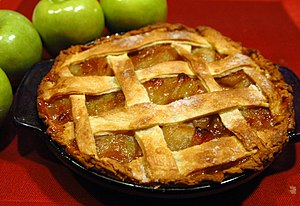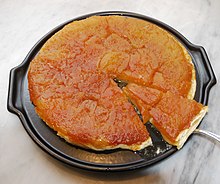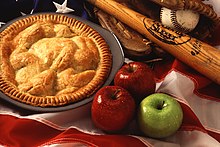Apple pie: Difference between revisions
No edit summary |
No edit summary |
||
| Line 58: | Line 58: | ||
{{seealso|List of American foods}} |
{{seealso|List of American foods}} |
||
[[Image:Motherhood and apple pie.jpg|thumb|An apple pie is one of a number of American [[cultural icon]]s.]] |
[[Image:Motherhood and apple pie.jpg|thumb|An apple pie is one of a number of American [[cultural icon]]s.]] |
||
[[Apple pie]] was brought to the English colonies by the [[British]], [[Dutch]], and [[Swedes]] during the 17th and 18th centuries. |
|||
In the English colonies the apple pie had to wait for the planting of European varieties, brought across the [[Atlantic ocean|Atlantic]], to become fruit-bearing apple trees, to be selected for their cooking qualities as there were no native apples.<ref name=app>{{cite web |
In the English colonies the apple pie had to wait for the planting of European varieties, brought across the [[Atlantic ocean|Atlantic]], to become fruit-bearing apple trees, to be selected for their cooking qualities as there were no native apples.<ref name=app>{{cite web |
||
| Line 83: | Line 85: | ||
Advertisers exploited the patriotic connection in the 1970s with the commercial jingle "[[baseball]], [[hot dog]]s, apple pie and [[Chevrolet]]". There are claims that the Apple Marketing Board of New York State used such slogans as "An apple a day keeps the doctor away"<ref>This is based on a proverb from Pembrokeshire which dates from 1866 ''A Dictionary of Proverbs'' By John Simpson 2009 ISBN 9780199539536</ref> and "as American as apple pie!",<ref>This is a shortened version of "As American as motherhood and apple pie". ''United States of Pie'' By Adrienne Kane 2012 ISBN 9780062064080</ref> and thus "was able to successfully 'rehabilitate' the apple as a popular comestible" in the early 20th century when [[prohibition]] outlawed the production of hard cider.{{dubious|date=October 2012}}<ref>{{cite web|url=http://boards.straightdope.com/sdmb/archive/index.php/t-116865.html |title=What's so American about apple pie? |publisher=Boards.straightdope.com |date= |accessdate=2013-11-05}}</ref> |
Advertisers exploited the patriotic connection in the 1970s with the commercial jingle "[[baseball]], [[hot dog]]s, apple pie and [[Chevrolet]]". There are claims that the Apple Marketing Board of New York State used such slogans as "An apple a day keeps the doctor away"<ref>This is based on a proverb from Pembrokeshire which dates from 1866 ''A Dictionary of Proverbs'' By John Simpson 2009 ISBN 9780199539536</ref> and "as American as apple pie!",<ref>This is a shortened version of "As American as motherhood and apple pie". ''United States of Pie'' By Adrienne Kane 2012 ISBN 9780062064080</ref> and thus "was able to successfully 'rehabilitate' the apple as a popular comestible" in the early 20th century when [[prohibition]] outlawed the production of hard cider.{{dubious|date=October 2012}}<ref>{{cite web|url=http://boards.straightdope.com/sdmb/archive/index.php/t-116865.html |title=What's so American about apple pie? |publisher=Boards.straightdope.com |date= |accessdate=2013-11-05}}</ref> |
||
Today, modern American recipes for apple pie usually indicate a confection that is 9 inches in diameter in a fluted pie plate with an apple filling spiced with cinnamon, nutmeg. and lemon juice, and may or may not have a lattice or shapes cut out of the top for decoration. <ref>{{cite book|last1=McBride-Carlton|first1=Jan|title=The Old Fashioned Cookbook|date=1975|publisher=Vineyard Books|isbn=0030146216|page=286|pages=367|edition=1st}}</ref> |
|||
The unincorporated community of [[Pie Town, New Mexico]] is named in honour of the apple pie.<ref>{{cite web|url=http://www.pietown.com/ |title=Pie Town New Mexico |publisher=Pietown.com |date= |accessdate=2013-11-05}}</ref> |
The unincorporated community of [[Pie Town, New Mexico]] is named in honour of the apple pie.<ref>{{cite web|url=http://www.pietown.com/ |title=Pie Town New Mexico |publisher=Pietown.com |date= |accessdate=2013-11-05}}</ref> |
||
Revision as of 10:58, 23 September 2014
 Apple pie with lattice upper crust | |
| Course | dessert |
|---|---|
| Main ingredients | cooking apples, sugar |
| 265 kcal (1110 kJ) | |

An apple pie is a fruit pie (or tart) in which the principal filling ingredient is apple. It is sometimes served with whipped cream or ice cream on top, or alongside cheddar cheese. Pastry is generally used top-and-bottom, making it a double-crust pie, the upper crust of which may be a circular shaped crust or a pastry lattice woven of strips; exceptions are deep-dish apple pie with a top crust only, and open-face Tarte Tatin.
Ingredients
Cooking apples[1] (culinary apples), such as the Bramley, Empire, Northern Spy or Granny Smith, are crisp and acidic. The fruit for the pie can be fresh, canned, or reconstituted from dried apples. This affects the final texture, and the length of cooking time required; whether it has an effect on the flavour of the pie is a matter of opinion. Dried or preserved apples were originally substituted only at times when fresh fruit was unavailable.
Apple Pie is often served in the style of "a la Mode" (topped with ice cream). Alternatively, a piece of cheese (such as a sharp cheddar) is occasionally placed on top of or alongside a slice of the finished pie.[2][3][4]
The English pudding

English apple pie recipes go back to the time of Chaucer. The 1381 recipe (see illustration at right) lists the ingredients as good apples, good spices, figs, raisins and pears. The cofyn of the recipe is a casing of pastry. Saffron is used for colouring the pie filling.
In English speaking countries, apple pie is a dessert of enduring popularity, eaten hot or cold, on its own or with ice cream, double cream, or custard.
Absence of sugar in early English recipe
Most modern recipes for apple pie require an ounce or two of sugar, but the earliest recipe does not. There are two possible reasons.
Sugarcane imported from Egypt was not widely available in 14th-century England, where it cost between one and two shillings per pound—this is roughly the equivalent of US$100 per kg (about US$50 per pound) in today's prices.[5]
Honey, which was many times cheaper, is also absent from the recipe, and the "good spices" and saffron, all imported, were no less expensive and difficult to obtain than refined sugar. Despite the expense, refined sugar did appear much more often in published recipes of the time than honey, suggesting that it was not considered prohibitively expensive. With the exception of apples and pears, all the ingredients in the filling probably had to be imported. And perhaps, as in some modern "sugar-free" recipes, the juice of the pears was intended to sweeten the pie.
Dutch style
Traditional Dutch apple pie comes in two varieties, a crumb (appelkruimeltaart) and a lattice (appeltaart) style pie, both recipes are distinct in that they typically call for flavourings such as cinnamon and lemon juice to be added and differ in texture, not taste.[6] Dutch apple pies may include ingredients such as raisins and icing, in addition to ingredients such as apples and sugar, which they have in common with other recipes.[7]
Recipes for Dutch apple pie go back centuries. There exists a painting from the Dutch Golden Age, dated 1626, featuring such a pie. A recipe in a late medieval Dutch cook book 'Een notabel boecxken van cokeryen' (from around 1514)[8] is almost identical to modern recipes.
The basis of Dutch apple pie is a crust on the bottom and around the edges. This is then filled with pieces or slices of apple, usually a crisp and mildly tart variety such as Goudreinet or Elstar. Cinnamon and sugar are generally mixed in with the apple filling. Atop the filling, strands of dough cover the pie in a lattice holding the filling in place but keeping it visible or cover the pie with crumbs. It can be eaten warm or cold, sometimes with a dash of whipped cream or vanilla ice cream. In the US, "Dutch apple pie" refers specifically to the apple pie style with a crumb, streusel, topping.[9]
Swedish style
The Swedish style apple pie is predominantly a variety of apple crumble, rather than a traditional pastry pie. Often breadcrumbs are used (wholly or partially) instead of flour, and sometimes rolled oats. It is usually flavoured with cinnamon and served with vanilla custard or ice cream. There is also a very popular version called äppelkaka (apple cake), which differs from the pie in that it is a sponge cake baked with fresh apple pieces in it.
Apple pie in American culture

Apple pie was brought to the English colonies by the British, Dutch, and Swedes during the 17th and 18th centuries.
In the English colonies the apple pie had to wait for the planting of European varieties, brought across the Atlantic, to become fruit-bearing apple trees, to be selected for their cooking qualities as there were no native apples.[10] In the meantime, the colonists were more likely to make their pies, or "pasties", from meat rather than fruit; and the main use for apples, once they were available, was in cider. However, there are American apple pie recipes, both manuscript and printed, from the 18th century, and it has since become a very popular dessert[citation needed]. All apple varieties are propagated by grafting, as clones, but in the New World, planting from seeds was more popular, which quickly led to the development of hundreds of new native varieties.[11]
Apple pie was a common food in 18th-century Delaware. As noted by the New Sweden historian Dr. Israel Acrelius in a letter: "Apple pie is used throughout the whole year, and when fresh Apples are no longer to be had, dried ones are used. It is the evening meal of children."[12]
A mock apple pie, made from crackers, was possibly invented by pioneers on the move during the 19th century who were bereft of apples. In the 1930s, and for many years afterwards, Ritz Crackers promoted a recipe for mock apple pie using its product, along with sugar and various spices.[13]
Although apple pies have been eaten since long before the European colonisation of the Americas, "as American as apple pie" is a saying in the United States, meaning "typically American".[14] In the nineteenth and twentieth centuries, apple pie became a symbol of American prosperity and national pride. A newspaper article published in 1902 declared that "No pie-eating people can be permanently vanquished."[15] The dish was also commemorated in the phrase "for Mom and apple pie" - supposedly the stock answer of American soldiers in World War II, whenever journalists asked why they were going to war.[16] Jack Holden and Frances Kay sang in their patriotic 1950 song The Fiery Bear "We love our baseball and apple pie We love our county fair We'll keep Old Glory waving high There's no place here for a bear", creating contrast between the popular view of the U.S. culture and that of the Soviet Union.
Advertisers exploited the patriotic connection in the 1970s with the commercial jingle "baseball, hot dogs, apple pie and Chevrolet". There are claims that the Apple Marketing Board of New York State used such slogans as "An apple a day keeps the doctor away"[17] and "as American as apple pie!",[18] and thus "was able to successfully 'rehabilitate' the apple as a popular comestible" in the early 20th century when prohibition outlawed the production of hard cider.[dubious – discuss][19]
Today, modern American recipes for apple pie usually indicate a confection that is 9 inches in diameter in a fluted pie plate with an apple filling spiced with cinnamon, nutmeg. and lemon juice, and may or may not have a lattice or shapes cut out of the top for decoration. [20] The unincorporated community of Pie Town, New Mexico is named in honour of the apple pie.[21]
See also
- Apfelstrudel (apple strudel), an Austrian pie-like dish made with dough, apples, sugar and spices.
- Apple cake
- Apple cobbler
- Tarte Tatin, a French variant on apple pie.
References
- ^ "Cooking apple". The Free Dictionary By Farlex. Retrieved 14 June 2012.
- ^ "An apple pie without the cheese". 2012 Apartment Therapy. Retrieved 14 June 2012.
- ^ "Apple Pie". OChef. Retrieved 7 April 2012.
- ^ "Product Highlight: Apple Pie, Sharp Cheddar, and A Nice Cup of Coffee". Hunger Mountain Coop. Retrieved 7 April 2012.
- ^ "How Sugar is Made - the History, Sugar Knowledge International". Sucrose.com. Retrieved 5 November 2013.
- ^ "Recipe: More apple cakes: Hollandse appeltaart aka Dutch Apple Tart". Recipes Tap. Retrieved 5 November 2013.
- ^ "page 21 "De verstandige kock of sorghvuldige huyshoudster (anno 1669)"". Retrieved 5 November 2013.
- ^ "Home Notabel Boecxken van Cokeryen door Thomas vander Noot (1514)". Kookhistorie.nl. 13 August 2002. Retrieved 5 November 2013.
- ^ "Dutch Apple Pie". Brown Eyed Baker. Retrieved 5 November 2013.
- ^ "Origin, History of cultivation". University of Georgia. Archived from the original on 21 January 2008. Retrieved 12 February 2013.
The center of diversity of the genus Malus is the eastern Turkey, southwestern Russia region of Asia Minor. Apples were improved through selection over a period of thousands of years by early farmers. Alexander the Great is credited with finding dwarfed apples in Asia Minor in 300 BC; those he brought back to Greece may well have been the progenitors of dwarfing rootstocks. Apples were brought to North America with colonists in the 1600s, and the first apple orchard on this continent was said to be near Boston in 1625.
- ^ http://www.usapple.org/consumers/all-about-apples/history-and-folklore/apples-in-america
- ^ Stradley, Linda. "Apple Pie - History of Apple Pie". What's Cooking America.net. Archived from the original on 10 June 2011. Retrieved 2 July 2011.
{{cite web}}: Unknown parameter|deadurl=ignored (|url-status=suggested) (help) - ^ By Beth Kracklauer <! (28 February 2008). "Putting on the Ritz". Saveur.com. Retrieved 5 November 2013.
- ^ Cambridge University Press (2011). "Definition of "as American as apple pie"". Cambridge Advanced Learner's Dictionary & Thesaurus.
- ^ "Popular Apple Sayings". U.S. Apple Association. Archived from the original on 1 July 2011. Retrieved 2 July 2011.
{{cite web}}: Unknown parameter|deadurl=ignored (|url-status=suggested) (help) - ^ "Pie idioms on PieMaven". Piemaven.com. 3 May 1921. Retrieved 5 November 2013.
- ^ This is based on a proverb from Pembrokeshire which dates from 1866 A Dictionary of Proverbs By John Simpson 2009 ISBN 9780199539536
- ^ This is a shortened version of "As American as motherhood and apple pie". United States of Pie By Adrienne Kane 2012 ISBN 9780062064080
- ^ "What's so American about apple pie?". Boards.straightdope.com. Retrieved 5 November 2013.
- ^ McBride-Carlton, Jan (1975). The Old Fashioned Cookbook (1st ed.). Vineyard Books. p. 286. ISBN 0030146216.
{{cite book}}: More than one of|pages=and|page=specified (help) - ^ "Pie Town New Mexico". Pietown.com. Retrieved 5 November 2013.
External links
- Food Timeline history Notes: Apple Pie
- A Apple Pie, by Kate Greenaway, 1886. Woodblock printed children's book, based on a much earlier rhyme; from Project Gutenberg
- The Dutch Table: Dutch Apple Pie
- Dutch Apple Pie Recipe by Liesbeth de Vos

